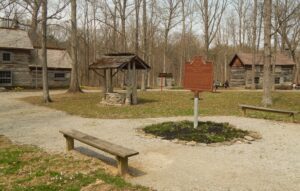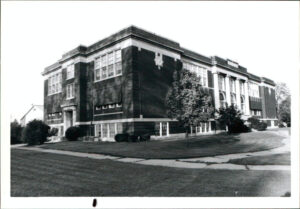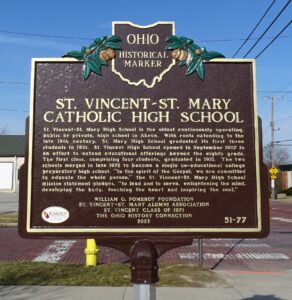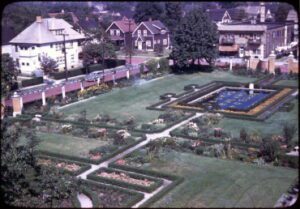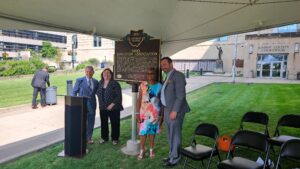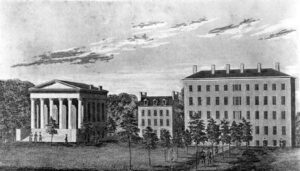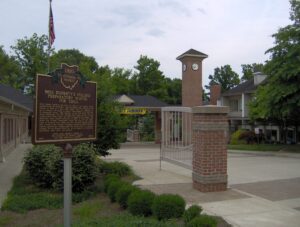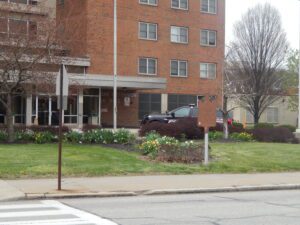, OH
Edward Bebb, father of William Bebb and first Welshman to settle in Paddy’s Run, Morgan Township, Butler County purchased this cabin in 1801. Originally the cabin stood four miles southeast of this site on the Dry Fork of the Whitewater River. It was here that William Bebb was born on December 8, 1802, the first white child born in Butler County west of the Great Miami River. At the age of twenty, after attending district schools, William Bebb became a teacher. In 1826 he became the first teacher at Paddy’s Run School. Two years later Bebb and his wife opened a boarding school on his father’s farm. While teaching school he began the study of law and in 1831 passed the state bar examination. A year later he began to practice law in Hamilton, where he soon became an active politician. In 1840 he stumped the state for Harrison and Tyler and in 1846 he was nominated for Governor by the Whig party. He was elected on the slogan “Wm. Bebb and a Home Currency against David Tod and Pot Metal.” After his term as governor, Bebb served in a number of government positions until his retirement to his farm near Rockford, Illinois. He died on October 23, 1873.
, OH
The Lincoln School building stood at 2402 Central Avenue for almost a century. In 1919, a twenty-year bond levy provided for the construction of five schools, including the “new east school” Lincoln Elementary. Construction began in 1921 on the eight-acre site while students attended classes in temporary structures. Lincoln School opened in 1923 with 500 students enrolled. Lincoln Field, football grounds for McKinley High School’s “Middies,” stood behind Lincoln from 1930 until 1950 when Barnitz Field Stadium was built on South Main Street. Additions to the original Lincoln building included a maintenance annex in 1935 and a gymnasium in 1959. Lincoln School closed in November 1980 during a 1980-1981 Middletown City School District reorganization. Students from Lincoln and Sherman schools moved to the refurbished Roosevelt School at 2701 Central Avenue.
, OH
St. Vincent-St. Mary High School is the oldest continuously operating, public or private, high school in Akron. With roots extending to the late 19th century, St. Mary High School graduated its first three students in 1901. St. Vincent High School opened in September 1907 in an effort to extend educational offerings beyond the eighth grade. The first class, comprising four students, graduated in 1910. The two schools merged in late 1972 to become a single co-educational college preparatory high school. “In the spirit of the Gospel, we are committed to educate the whole person,” the St. Vincent-St. Mary High School mission statement pledges, “to lead and to serve, enlightening the mind, developing the body, touching the heart and inspiring the soul.”
, OH
The Village of Collinwood was originally a part of Euclid Township of the Western Reserve and named after the death of railroad chief engineer Charles Collins in 1876. Originally known as “Frogsville,” the population of Collinwood dramatically increased in the 1870s, due partly to repair roundhouses of the Lake Shore & Michigan Southern Railroad. By 1901, the Village has grown to 7,500, and as a result, the schoolhouse, which once housed 200 students and four classrooms, had been enlarged twice to house 350 students in eight classrooms. Constructed in 1901, the Lakeview School was the site of a tragedy that reverberated across the nation and around the world. (Continued on other side)
, OH
On December 30, 1847, six educators met at the Summit County Courthouse to organize the first convention of the Ohio State Teachers’ Association, now known as the Ohio Education Association (OEA). The organizers Josiah Hurty (Richland County), Thomas W. Harvey (Geauga County), M.D. Leggett (Summit County), Lorin Andrews (Ashland County), William Bowen (Stark County), and Marcellus F. Cowdery (Lake County) hoped “to elevate the profession of teaching” and “to promote the interests of schools in Ohio.” In 1853, the General Assembly enacted the new association’s entire slate of proposals into law, thus ensuring free, universal, public education in Ohio. For 176 years, the Ohio Education Association has advocated for fair terms and conditions of employment for Ohio educators and for the betterment and improvement of public education for all students.
, OH
The Lanes, Baptist merchants from New Orleans, and the Kempers, a Presbyterian family from Cincinnati, gave money and land respectively for Cincinnati’s first manual labor theological seminary and high school, which opened in suburban Walnut Hills in 1829. The Reverend Lyman Beecher came from Boston as its first president. The president’s house, now known as the Stowe House after Beecher’s daughter Harriet Beecher Stowe, author of Uncle Tom’s Cabin, still remains at Gilbert and Foraker. Lane Theological Seminary, bound by present day Gilbert, Chapel, Park, and Yale streets, continued to educate Presbyterian ministers until 1932, when it was merged with McCormick Theological Seminary in Chicago.
, OH
Mary Harlan Doherty was born in 1862 in the Dayton Street neighborhood of Cincinnati. She graduated from Woodward High School in 1880 at a time when women were not expected to go to college, but rather to marry, raise children, and take care of household duties. Miss Doherty, as she was known, saw the world differently. She felt strongly that women should not only possess solid social skills, but also be prepared for college. She graduated from Cornell University in 1899. In 1906 she established the College Preparatory School for Girls in the former home of Superior Court Judge and Ohio Governor George Hoadley, with a class of 125 students. Enrollment doubled by 1920, with Miss Doherty guiding her students under the school’s motto, Ad Summum, meaning “To the Highest Point,” or, as she viewed it, to strive for excellence, hard work, and service.
, OH
John Malvin (1795-1880) was an operative on the Underground Railroad and an ardent member of anti-slavery and abolitionist causes. Born in Dumfries, Virginia of a free mother and enslaved father, Malvin was apprenticed at an early age to learn carpentry and taught himself to read and write. In 1827, he moved to Cincinnati where he became an ordained preacher and an activist in the cause of freedom. In 1831, with his wife Harriet, he moved to Cleveland where he became a charter member of the First Baptist Church, a sawmill operator, and captain and owner of the canal boat Auburn. (continued on other side)


